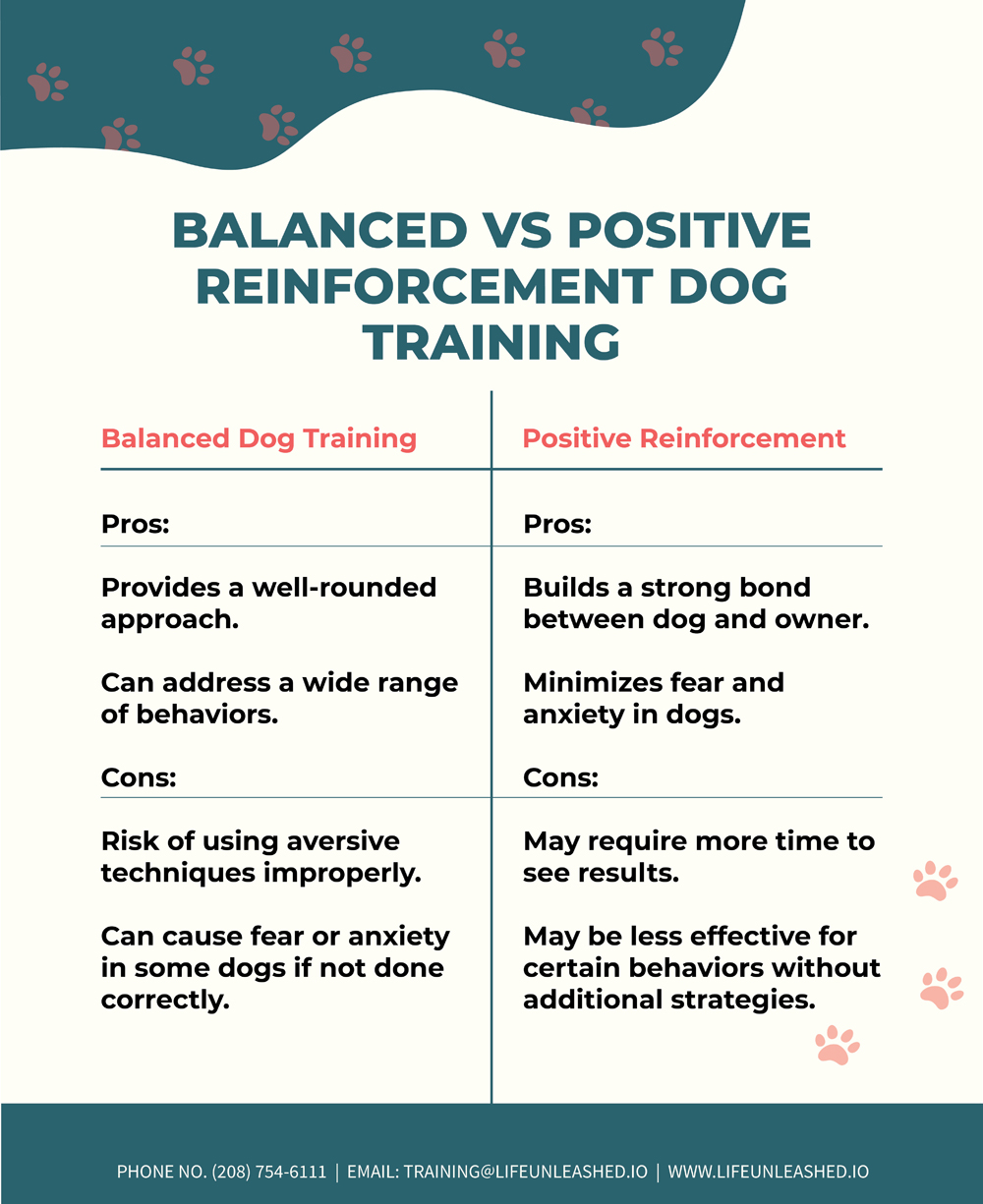Introduction:
When it comes to training our furry companions, it’s essential to employ effective and ethical methods. Two popular dog training techniques are balanced dog training and positive reinforcement. While both aim to teach your dog desired behaviors and foster a loving relationship, they differ in techniques and philosophies. This blog post outlines several crucial factors to consider when deciding which training approach is the best fit for you and your canine companion.
1. Training Goals:
Determine your training goals and what behaviors you want to address in your dog. Balanced training incorporates both positive and corrective techniques, making it suitable for dogs with behavioral issues or specific needs. Positive reinforcement, on the other hand, focuses on rewarding desired behaviors, making it a great choice for general obedience training or teaching new tricks.
2. Dog’s Personality and Sensitivity:
Consider your dog’s individual personality and sensitivity level. Some dogs may respond better to balanced training methods, which involve clear boundaries and consistent consequences. Conversely, sensitive or anxious dogs may thrive with positive reinforcement, as it emphasizes praise and rewards, promoting a positive association with training.
3. Trainer Expertise:
Evaluate the expertise and qualifications of the trainers available to you. Balanced training requires a skilled and knowledgeable trainer to ensure proper implementation of aversive techniques without causing harm or distress to your dog. Positive reinforcement training may be comparatively easier for beginners, as it relies on rewards and motivational techniques.
4. Ethical Considerations:
Consider the ethical implications of both training methods. Balanced training involves the use of aversive elements such as mild corrections, which can cause stress or fear in some dogs. Positive reinforcement training relies solely on rewards and praise, promoting a trusting and mutually enjoyable training experience.
5. Long-Term Relationship:
Reflect on your desired long-term relationship with your dog. Balanced training may help establish consistent boundaries and ensure your dog understands rules, making it a suitable choice if you want your dog to respond to commands reliably. Positive reinforcement training fosters a deep bond built on trust, respect, and cooperation.
6. Time and Dedication:
Evaluate the amount of time and dedication you can invest in the training process. Balanced training methods often require more effort and time to understand and implement correctly. Positive reinforcement training demands patience and consistency in rewarding desired behaviors, which can also be time-consuming.
7. Training Resources:
Consider the availability and practicality of training resources such as treats, toys, and training aids. Positive reinforcement relies heavily on rewards, so having a readily available supply of treats can aid in the training process. Balanced training may require additional tools such as leashes or training collars, which should be used responsibly and under professional guidance.

Conclusion:
Balanced dog training vs positive reinforcement is a complex matchup and choosing between either of the two dog training techniques should be based on a comprehensive evaluation of various factors. Understanding your dog’s needs, your training goals, and your personal ethics will guide you towards the most suitable training method. Remember, both approaches have their merits, and with the right guidance, your dog can flourish with either method, creating a harmonious and loving bond.
FAQs About Balanced vs Positive Reinforcement Dog Training
What is balanced training?
Balanced dog training is an approach that combines both rewards and gentle corrections to guide a dog’s behavior. The idea is to encourage good behavior by using treats, toys, or praise while also setting clear boundaries with mild corrections if the dog ignores commands or acts out.
This method aims to teach dogs what’s expected of them in a balanced way—rewarding them when they do things right and gently correcting them when they need guidance. For many, it strikes a balance between positive-only techniques and firmer methods, helping dogs learn to listen and behave in a well-rounded way.
Which method is better for new dog owners?
For new dog owners, positive reinforcement is often recommended. It’s easier to implement, reduces the risk of causing fear or anxiety in your dog, and helps build a positive relationship. Balanced training can be effective but requires a more nuanced understanding of dog behavior and proper techniques to avoid negative outcomes.
Are there specific behaviors that each method addresses better?
Balanced training can be useful for addressing behaviors that might be resistant to change through positive reinforcement alone, such as certain forms of aggression or severe behavioral issues.
Positive reinforcement is highly effective for teaching basic commands, tricks, and general obedience.
What tools are commonly used in balanced dog training?
Balanced dog training may use a variety of tools, including:
- Treats and toys for rewards.
- Leashes and collars for corrections.
- Clickers for marking desired behaviors.
- Verbal cues and commands.
What tools are commonly used in positive reinforcement dog training?
Positive reinforcement primarily relies on:
- Treats and toys.
- Clickers.
- Verbal praise and affection.
- Training sessions that set the dog up for success to encourage repeatable good behavior.
Can balanced dog training be harmful to my dog?
If not done correctly, balanced training can potentially cause fear, anxiety, or even aggression in some dogs. It’s crucial to understand proper techniques and to use aversive methods sparingly and appropriately.
How quickly can I expect results from each method?
The timeline for seeing results can vary:
- Positive reinforcement may take longer initially but often results in lasting behavioral changes.
- Balanced training might show quicker results in some cases but can require ongoing management and consistency.
Are there professional trainers who specialize in each method?
Yes, there are professional trainers who specialize in both balanced and positive reinforcement training. It’s important to choose a trainer whose methods align with your philosophy and who uses humane and effective techniques.
Can I combine both methods?
While some trainers advocate for combining both methods, it’s essential to have a thorough understanding of each approach. Improper use of aversive techniques can undermine the trust and bond with your dog. Consulting a professional trainer can help you navigate this combination effectively.
How do I know which method will work best for my dog?
Each dog is unique, and the best method may depend on your dog’s personality, history, and specific behavioral issues. Observing your dog’s response to different techniques and consulting with a professional trainer can help you determine the most effective approach.
What are the costs associated with each method?
Costs can vary widely depending on location and trainer:
Positive reinforcement classes or private sessions may range from $50 to $150 per session.
Balanced training sessions may have similar costs but could also require additional tools like specific collars or leashes, which might add to the expense.
Remember, investing in proper training is crucial for the long-term well-being and happiness of both you and your dog.
You can get in depth analysis of dog training cost in this article:
https://lifeunleashed.io/blog/ultimate-guide-to-calculating-dog-training-cost/



